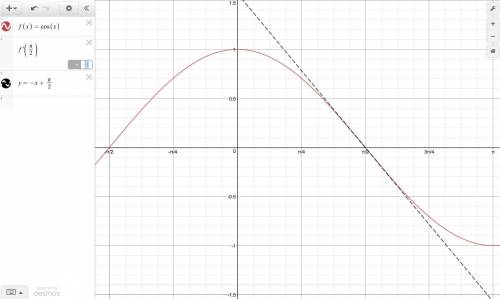
Mathematics, 21.07.2019 12:30 isabellacampos4586
F(x) = cos(x) f'(x) = -sin(x) f'(π/2) = -sin(π/2) f'(π/2) = -1 my answer to this question is a. -1, but i am posting it here because several students got b. +1 as their answer. can anyone confirm the answer as a?

Answers: 2


Other questions on the subject: Mathematics

Mathematics, 21.06.2019 18:00, safi30360oz0c34
Based on the graph, what is the initial value of the linear relationship? a coordinate plane is shown. a line passes through the y-axis at -2 and the x-axis at 3.
Answers: 3



Mathematics, 21.06.2019 23:50, dbag1162
The federal reserve controls certain interest rates in the united states. investors often try to speculate as to whether the federal reserve will raise or lower rates and by how much. suppose a company conducts extensive interviews with financial analysts, and as a result, predicts that "thefed" will increase rates by an average of 0.25 percentage points every six months for the forseeable future. which type of equation could be used to model the predicted interest rates over the next several years, assuming no other significant changes? a) a linear equation b) a quadratic equation c) a polynomial equation d) an exponential equation
Answers: 3
You know the right answer?
F(x) = cos(x) f'(x) = -sin(x) f'(π/2) = -sin(π/2) f'(π/2) = -1 my answer to this question is a. -1,...
Questions in other subjects:


English, 14.07.2019 19:00

Mathematics, 14.07.2019 19:00

Mathematics, 14.07.2019 19:00

Mathematics, 14.07.2019 19:00



Social Studies, 14.07.2019 19:00


Mathematics, 14.07.2019 19:00




